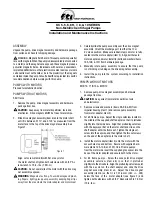
- 2 -
SMP10C24X Series Installation Guide
Overview:
Altronix SMP10C24X Series power supply/chargers convert a 115VAC, 60Hz input into a regulated 24VDC output
with up to 10A of continuous load current
(see specifications)
.
SMP10C24X Series Power Supply Configuration Reference Chart:
Altronix
Model Number
Accessory
Power
Distribution
Module(s)
Number
of
Outputs
Fused Outputs
PTC Outputs (auto- resettable)
Individual Output Rating (A)
Supervised
115VAC
50/60Hz
Input
Current
(A)
24VDC
Total
Output
Current
(A)
SMP10C24X
-
1
–
–
10A
–
2.7A
10A
SMP10PMC24X
–
–
P
SMP10PM24P4
PD4
4
P
–
3.5A
SMP10PM24P4CB
PD4CB
–
P
2.5A
SMP10PM24P8
PD8
8
P
–
3.5A
SMP10PM24P8CB
PD8CB
–
P
2.5A
SMP10PM24P16
PD16W
16
P
–
3.5A
SMP10PM24P16CB
PD16WCB
–
P
2.5A
Specifications:
Input:
• Input 115VAC, 50/60Hz, 2.7A.
Output:
• 24VDC output.
• 10A supply current.
• Filtered and electronically regulated outputs.
• Short circuit and thermal overload protection.
Battery Backup:
• Built-in charger for sealed lead acid or
gel type batteries.
• Maximum charge current 0.7A.
• Zero voltage drop when switching over to
battery backup.
Features:
• Power ON/OFF switch.
Supervision
(select models)
:
• AC fail supervision (form “C” contacts).
• Battery presence and low battery supervision
(form “C” contacts).
Visual Indicators:
• AC input and DC output LED indicators.
Electrical:
• Operating temperature: 0ºC to 49ºC ambient.
• BTU/Hr. (approx.): 122 BTU/Hr.
• System AC input VA requirement: 310.5VA.
Mechanical:
• Enclosure Dimensions (H x W x D approx.):
13.5” x 13” x 3.25”
(342.9mm x 330.2mm x 82.6mm)
- Accommodates up to
two (2)12VDC/7AH batteries.
Installation Instructions:
Wiring methods shall be in accordance with the National Electrical Code/NFPA 70/NFPA 72/ANSI, and with all
local codes and authorities having jurisdiction. Product is intended for indoor use only.
1. Mount unit in the desired location. Mark and predrill holes in the wall to line up with the top two keyholes
in the enclosure. Install two upper fasteners and screws in the wall with the screw heads protruding. Place
the enclosure’s upper keyholes over the two upper screws; level and secure. Mark the position of the lower
two holes. Remove the enclosure. Drill the lower holes and install the three fasteners. Place the enclosure’s
upper keyholes over the two upper screws. Install the two lower screws and make sure to tighten all screws
(Enclosure Dimensions, pg. 8)
. Secure enclosure to earth ground.
2. Slide [Power ON/OFF] switch t o OFF position
(Fig. 1a, pg. 4)
.
3. Connect AC power to the terminals marked [L & N], connect ground to the green flying lead
(Fig. 1, pg. 4,
Fig. 2, pg. 5)
.
Use 18 AWG or larger for all power connections (Battery, DC output).
Use 22 AWG to 18 AWG for power-limited circuits (AC Fail/Low Battery reporting).
4. Slide [Power ON/OFF] switch to ON position.
5. Measure output voltage before connecting devices. This helps avoiding potential damage.
Keep power-limited wiring separate from non power-limited wiring (115VAC, 60Hz Input,
Battery Wires). Minimum 0.25” spacing must be provided.


























